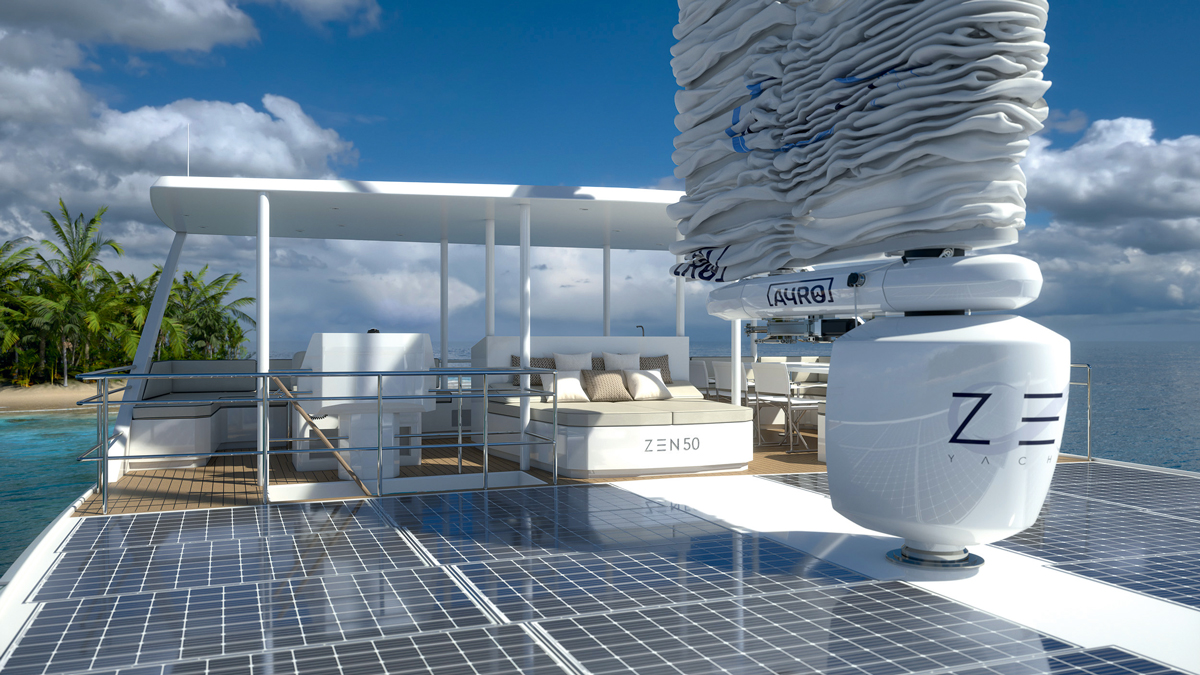Claimed to be the world’s first true zero-emissions 50ft powercat, the ZEN 50 carries no fossil fuels whatsoever thanks to a host of innovative new technologies…
Exactly what is this strange-looking vessel? Is it a motor boat, a sailing yacht or something completely different? The answer lies somewhere between all three because although the ZEN 50 is at heart a solar-powered electric motorcat, it also has a small mast and sail.
However, this is no ordinary canvas rig but an automated wingsail that requires no previous sailing experience to operate.
Julien Melot, the ZEN 50’s designer, prefers to describe it as a “range and speed extender”, deliberately eschewing any sailing references in favour of a term usually reserved to describe the diesel-powered generators which most other solar-powered electric boats rely on to boost their limited speed and range.
In his view, resorting to a generator for this purpose is a bit of a cop-out that requires carrying and burning substantial quantities of fossil fuel, especially in low light conditions.
The ZEN 50 is entirely self-sufficient without the need for a generator or a single drop of fossil fuel – even the tender is battery-powered and charged by the mothership. Instead, it harvests its own energy from the sun and wind, making it the world’s first truly zero-emissions 50ft production powercat.
Speed of light
It all starts with a clean sheet design making full use of carbon fibre and Corecell sandwich construction to build a light but strong multihull shape with efficient hydrodynamics and the largest possible array of solar panels.
The ZEN 50’s dry displacement of 16 tonnes and peak solar output of 16kW are said to give it an unrivalled solar power to displacement ratio of 1:1.
This light, slippery hull shape also ensures it is easily driven by a pair of modest 40kW electric motors linked to saildrive legs and a substantial 160kWh lithium battery pack, giving it a top speed – under electric power alone – of 10 knots.
For many owners, this will be fast enough, and while the range will vary according to sun and sea conditions, ZEN claims it can cruise continuously at up to 4.5-5 knots without drawing on its battery reserves.
However, for those who want more speed and range and the added reassurance of a back-up propulsion system, buyers can also specify the optional OceanWings 32 wingsail.

The wingsail helps boost the speed and range of the electric motors and battery pack as well as providing additional redundancy
Designed and built by Ayro, it is the same system that was fitted to the experimental hydrogen-powered Energy Observer catamaran back in 2019 and has now benefitted from two years’ testing in the field.
Shaped like a two-piece vertical aeroplane wing rather than a traditional sail, the opposing surfaces create high pressure on one side and low pressure on the other to generate sideways ‘lift’, which the twin keels convert into forward motion.
This boosts the top speed to 14 knots but more importantly enables cruising speeds of 6-10 knots under solar and sail power alone.
Developed primarily for ease of use rather than speed, it has an electrically powered free-standing mast with no additional rigging to clutter the decks.
The two sail sections, which form the semi-rigid wing, raise and lower electronically too, and all the trimming and adjustments are taken care of automatically.
The helm simply has to steer the boat and decide how much additional electric drive to dial in. Any excess solar power is then stored in the main battery bank.
A second 10kWh back-up battery ensures there is always enough power to run the boat’s systems, including the wingsail, nav gear and communications.
Life of luxury
Any concerns that all this zero-emissions tech might restrict the comforts of life aboard or prove too fragile for extended cruising are countered by the ZEN 50’s impressive stats.
It is Category A rated for offshore cruising and can sleep as many as 12 people across six cabins and two convertible sofas.
However, private buyers are more likely to opt for the owner version with its luxurious master suite occupying most of the starboard hull – with no big engines or generators to accommodate, the full length of both hulls can be used for accommodation.
Nor does the lack of fossil fuel limit the fun you can have at anchor; as well as the electric tender you can add a dive compressor, e-foil board, Seabob or any number of other toys.
The only visible hurdle we can see is the ZEN 50’s rather uncompromising looks dictated by the two large arrays of solar panels doubling as sunshades for the flybridge and foredeck.
If you can live with this, then the dream of a genuine zero-emissions motoryacht is well on the way to being realised.
The first ZEN 50 is already in build and, once completed, ZEN will calculate the carbon footprint of the construction process as well with a view to achieving net zero by 2030.
ZEN 50 specifications
LOA: 51ft 6in (15.7m)
Beam: 26ft 7in (8.4m)
Displacement: 16 tonnes
Draught: 4ft 3in (1.3m)
Motors: 2 x 40 kW electric saildrive
Batteries: Main 160 kWh, Back-up 10 kWh
Top speed: 10 knots (electric only), 14 knots (electric and wingsail)
Cruising speed: 8-10 knots (day time)
Range over 24h: 180nm
RCD category: A for 12 persons
First published in the June 2022 issue of MBY.

The wingsail is raised and lowered electrically. Automatic adjustment means no previous sailing experience is required to operate it

The combination of solar electric and wingsail power are said to make this the first true zero emmissions cruising powercat















